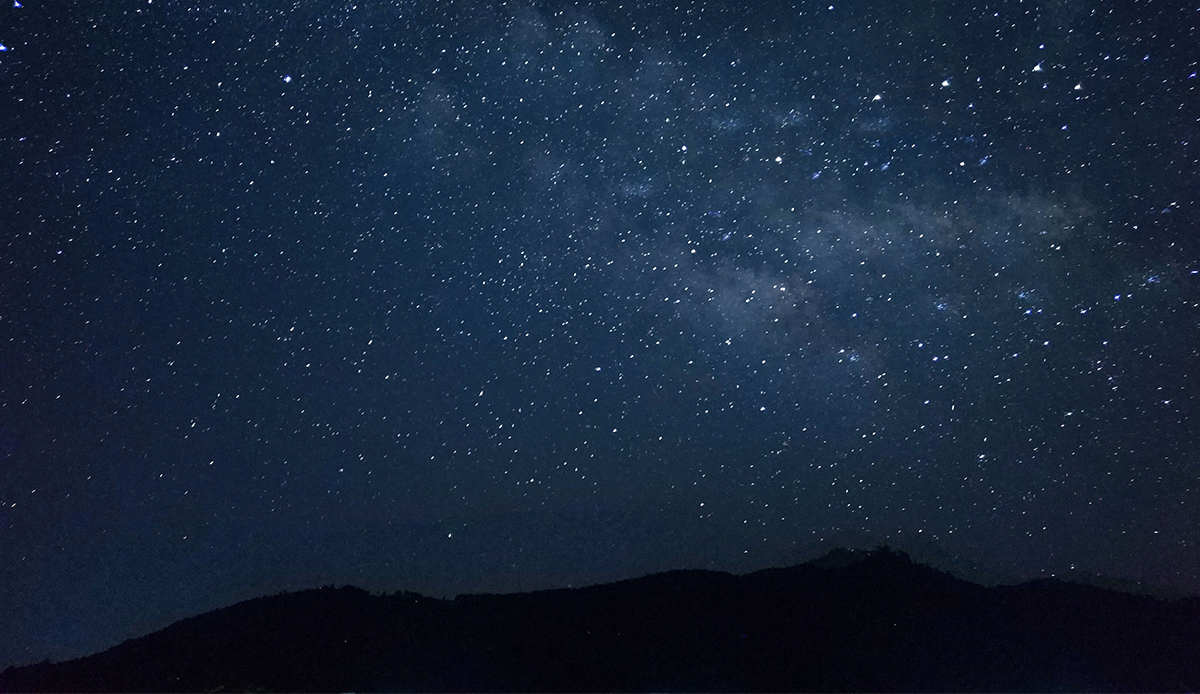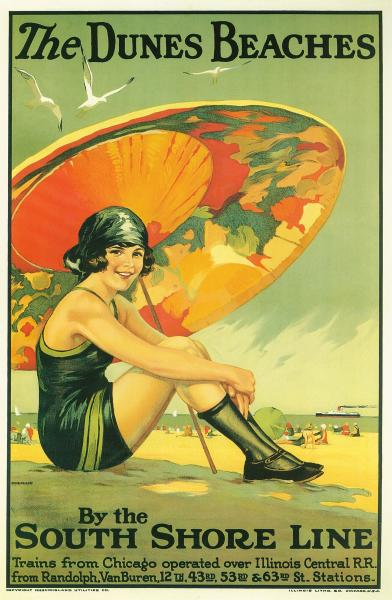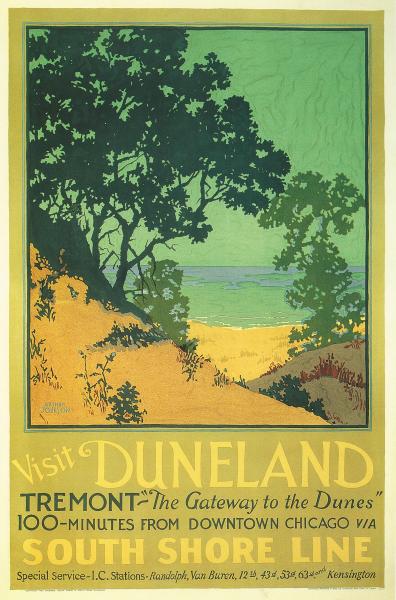The Posters of the South Shore Line
THE DUNES BEACH REDUX
Let’s try again. It’s summer! There are the same three white gulls. There are the same white faces. But there are no dunes. How is that possible? The beach is flat in this poster. It is easy to access. And on that easy-to-access beach there is a beautiful young woman in her scandalous black wool suit and she is smiling at you. She’s sitting underneath an umbrella with splotches of greens and corals and golds like fruit and honey. The umbrella is larger than the beach, it fills the sky, it will protect her glowing white skin. There is a ribbon of white sand on the underside of her right thigh, you can see the artist may have enjoyed placing it right where he places it, the white of her fingernails, the black socks rolled down mid-calf, the watery silk of the scarf that covers her bobbed hair. A lovely smile. Is she a woman or a girl? There’s a freighter offshore, heading to the mills, but she’s unaware of it because she’s gazing at you, the gazer.
The Dunes Beaches where there are no dunes. By the South Shore Line.
VISIT DUNELAND: TREMONT "THE GATEWAY TO THE DUNES"
Or rather, the Dunes are the gateway to the lake. In this poster a gold dune slants in an accent grave and a gray one, shadowed, in an accent acute. There’s a triangle of sand in the V where they meet and above that grayed spa colors of celadon and periwinkle and once again celadon for the sky. The blue spreads like slime trails in the sky, or like amoebas, like the motion of Van Gogh’s wheat fields. Was this poster designer mad? The trees are hunter green, both the leaves and bark.
This world in this poster is idyllic despite the possible madness of the artist. Trees and lake and sand. But on the gray dune, as opposed to the golden one where the grasses are green, there is a line of matching grasses and they’re red. Quite small in comparison to the rest. Blood red and they look like a row of bloodied people standing, some of them with their arms in the air. Look at me, they say. Make sense of this.
Why did the artist put them there? The artist didn’t put them there. He was mad! He put grasses in a shadowed dune and chose the complementary of the green he used, which in this case is blood red. Still, they’re there, and once you see them you can’t unsee them.
Visit Duneland. Tremont, the Gateway to the Dunes. 100 Minutes from downtown Chicago Via the South Shore Line.
DUNES WOODLAND
The cool pines of the inland dunes, the ponds and bogs and marshes. Before the nineteenth century, it was uninhabited. Humans would run in for furs or blueberries and they would quickly leave. It was the heart of the heart of the interior of the North American continent, and the mud was shoulder deep.
It was the Eden of this country, and in this place the western habitats met the eastern habitats. It was the only place on the continent where the two habitats would meet and shake hands like this: the prickly pear cactus of the deserts next to eastern woodland plants like trillium.
“There are few places on our continent where so many species of plants are found in so small a compass,” Henry Chandler Cowles, the founder of ecology, explained.
Within a stone’s throw of almost any spot one may find plants of the desert and plants of rich woodlands, plants of the pine woods, and plants of swamps, plants of oak woods and plants of the prairies.
Here one may find the prickly pear cactus of the southwestern desert hobnobbing with the bearberry of the arctic and alpine regions. One is almost startled at the number of plants of the far north, many of which, like the jack pine, are not found to the southward of our dunes.
Among such plants of the Canadian forest and tundra are the twin flower, the glandular willow, the poverty grass, and the northern rose. Northern plants are particularly characteristic of the dune swamps, and embrace such interesting species as the larch, bunchberry, dwarf birch, sage willow, orchids, cranberry, leatherleaf, and many more. Many of these species are found nowhere for many miles outside of the dune region, so that the failure to conserve the Dunes would result in the extinction of this wonderful flora for all time.
And there are acres of sand “stretching up and down the lake, billowy like a prairie or vast drifts of snow.” They drift in dunes that are stationary, dunes that are active or wandering, dunes that are passive and established.
Like a volcano with its lava flow, the dune is a moving landscape, and it moves, according to Cowles, “indifferently over swamp or town or forest.” Forests are buried by sand but the plants “do not yield supinely.
“Many species, such as oaks and pines, give up very quickly, but others such as the cottonwood, various willows, wild grape, and dogwood, display an astonishing resistance, growing up and up as the sand advances near them.”
In this place there is world-building. Nowhere else in the world could you walk inland a mile and walk back through thousands of years of plant succession.
But Cowles’s words were for a congressional committee, and this poster is for tourists. What you can’t see in the poster is the scientists from the University of Chicago with their smiles and Indiana Jones hats and jackets leading their students on junkets across floating spongy thick green bogs into the omphalos, the cradle of all that breathes. Plants that have sex in the air and eat the sun and defend their territories while staying put. Plants that compete but, more importantly, plants that work together for survival.
Henry Chandler Cowles worked outside this poster. In the years that US Steel becomes the largest steelmaker in the world, the “nothingness” of these dunes are his “chief reason for existence.” In 1914 when a group of the greatest scientists in the world came to the United States (scientists from all the countries which were, at the time of this poster, at war with one another) the things they agreed they wanted to see were the Grand Canyon, Yosemite, Yellowstone Park and these Lake Michigan Dunes.
But the poster has this one moment, not centuries, to grab your attention! The designer has the reeds growing out of a blue-green pond, the outline of a dogwood, in that red-orange the poster designers favor, though dogwoods never do, and behind the dogwood an explosion of green—something that’s supposed to be a tree I suppose—billows toward a chartreuse sky, like smoke. And behind other trees, delicate green lacework, is more of that red orange. Now it’s not contained in the form of something natural like a tree. It’s the fire of the boilers and the coke ovens and the foundries. The designer cannot forget them. They haunt his dreams.
Dunes Woodland. Trains from Chicago operated over the Illinois Central Railroad. By South Shore Line.
DUNES BEACH PART III
Yes, you can believe it, there is a beach in landlocked Indiana. We will change the perspective here so that the woman/girl is running toward you. She is like a linebacker and she holds her white dog in her arm like a football and she carries a parasol that is a ring of green like a halo around her head and her swimming hat is red with a white band and her suit is red and her legs are muscled and white with even lighter white where the suns glistens on the muscles and her feet where they run toward you from the green of the shallow water to the deeper slate color of the water where you are standing looking toward her, perhaps slightly up at her with the hills of sand behind her and a dark blue sky and she is smiling and there are ten people spread out on the beach behind her, all posing, all white.
Visit the Dunes Beaches. Then return to your home! Avert your eyes from the mills as you fly past them. Visit the Dunes Beaches. By South Shore Line.
DUNES BEACHES PART IV
Let’s try again.
It is so very hard to believe in a beach in the heartland which is, by definition, beachless.
What makes the coasts the thing they are is the ocean, which makes them the edge, which makes them edgy, which makes them not the static center.
So we have to try very hard and several times to make you believe in the existence of what is left of a beach that used to be of course much larger.
What is left of beach is a museum of beach. This is all that was left quite quickly after the founding of US Steel and Gary.
This poster is my favorite. There is a woman in a red bathing suit. Her bathing suit is cut the length of a tennis skirt. It is a scandalous length, but she is a drawn woman, not a living breathing one, so she can be scandalous. The woman stands in the shade on top of a darkened dune. She is facing away from us this time. She is apparently dancing. In her left hand she holds a bouquet of something that is supposed to be flowers but which, since she’s in shade, looks like a bit of the tree, the color and shape of broccoli. She is wearing ballet shoes with ribbons laced to her knee. Her right arm is raised and her right hand looks like a gull. And in fact there are three pale gulls stretching from her gull-shaped hand. She is the mother of gulls! And beyond that, the boat heads to the Port of Indiana.
The woman’s hair is red.
She is dappled with light in the shape of more birds.
She is ready to fly down the hill of sand to her friends who are all looking out toward the lake. Her friends are lying on beach towels under umbrellas that look like hand-painted plates.
Come to the beaches of the heartland and see this beautiful woman, the poster artist says. Visit the Dunes Beaches! Again, avert your eyes on the way back home. Fall asleep in the railroad car, your skin covered with sand. Fall asleep and dream of your admirers. Perhaps one of those admirers kissed you. Perhaps you wished one would. Fall asleep and dream of the Dunes beaches.
By the South Shore Line.
Recommended
Nor’easter
Post-Op Appointment With My Father
Cedar Valley Youth Poet Laureate | Fall 2024 Workshop







